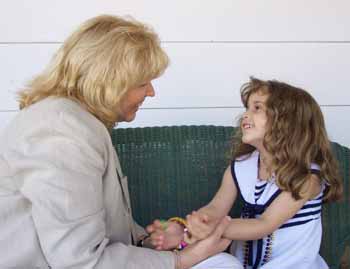
learns to cope with rare illness A year ago in February, the Barone family of Hamlin was confronted by puzzling, chronic symptoms in their previously healthy three-year-old. Olivia, who is now a four-and-a-half-year-old preschooler, began to experience high fevers, up to 106 degrees, that would last for three weeks. She developed sores in her mouth and on other parts of her body, and rashes on her arms and legs. Dark lines appeared on her ankles and moved up her legs to her torso. Olivia began to complain of pain in her legs and was sometimes unable to walk. For eight months, the Barones took their daughter to different specialists searching for a diagnosis that would explain the symptoms. Olivia spent those months in and out of the hospital, while her parents learned what she didn’t have. Finally, while searching for answers on the internet, Kathy Barone came up with something that seemed to fit her daughter’s symptoms - Behcet’s Disease. Shortly afterwards, doctors confirmed the diagnosis. Behcet’s Disease is an autoimmune disease that causes inflammation of blood vessels, particularly veins. It strikes the eyes, joints, skin, mucous membranes, and internal organs. The cause is unknown but researchers believe that an inherited abnormality of the immune system makes some people susceptible to the disease, which is then "triggered" by an unknown agent. In its active stages, called flares, Behcet’s can appear in different ways – as ulcers in the digestive tract or clots in the legs, for example. The next flare may involve different engagements. Between flares patients enter remission. It is thought that the periods of remission are entered naturally, but that combinations of medications can help move patients into remission and extend its length. The disease can be life threatening. Treatment is geared to reducing discomfort and preventing complications such as stroke and blindness. Although Behcet’s Disease usually strikes adults in their 20s or 30s, it is becoming more common in children. Kathy Barone said there are six children diagnosed with Behcet’s, which is also called the Silk Route Disease, in western New York. Olivia has been in remission since the fall. Unlike some patients, during her remission, Olivia’s activities are unrestricted. For Kathy though, even remission means constant vigilance – a sharp eye out for symptoms to begin anew. "Young children aren’t always able to tell you exactly what’s bothering them," she said. "Olivia may not realize that what she’s feeling could be the beginning of another flare." Although not medically documented, Kathy has learned from the parents of other Behcet’s children, that puberty seems to bring on a rapid progression of the disease. That is still several years away for the Barone family. From feeling helpless, "It’s the worst thing in the world, to know your child is seriously ill and the doctor’s don’t know why," Kathy has begun to get involved in Behcet’s awareness. "I want to do what I can to help while Olivia is in this period of feeling well." Members of the Behcet’s Disease Organization are lobbying to have May 20 declared Behcet’s Disease Awareness Day around the world. Kathy is trying to organize a fundraising walk in the Rochester area for later this summer. Information about the disease is available at behcets.org |
